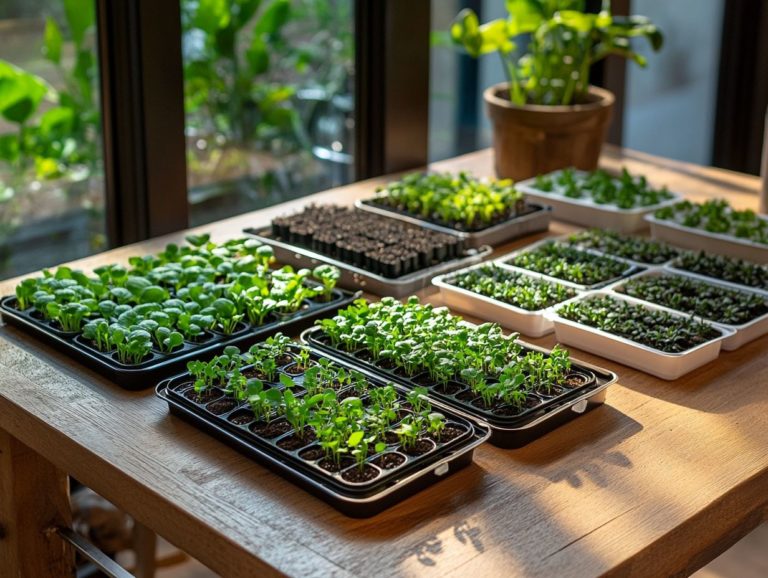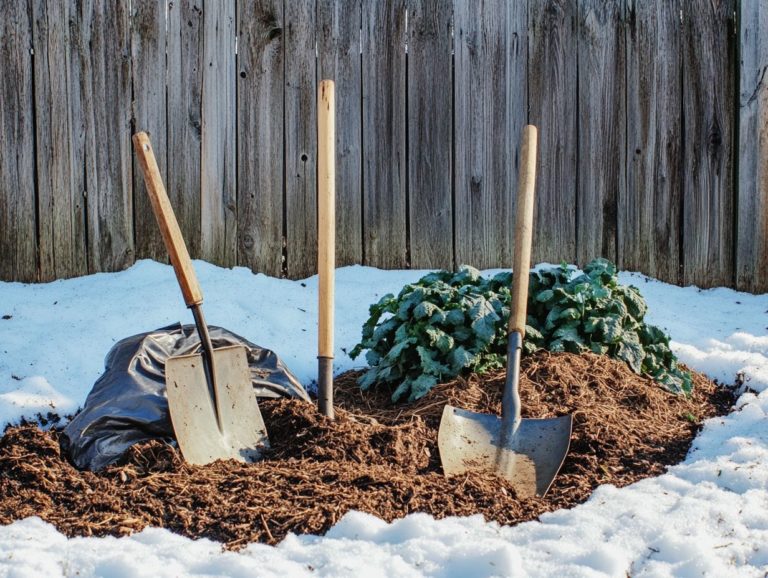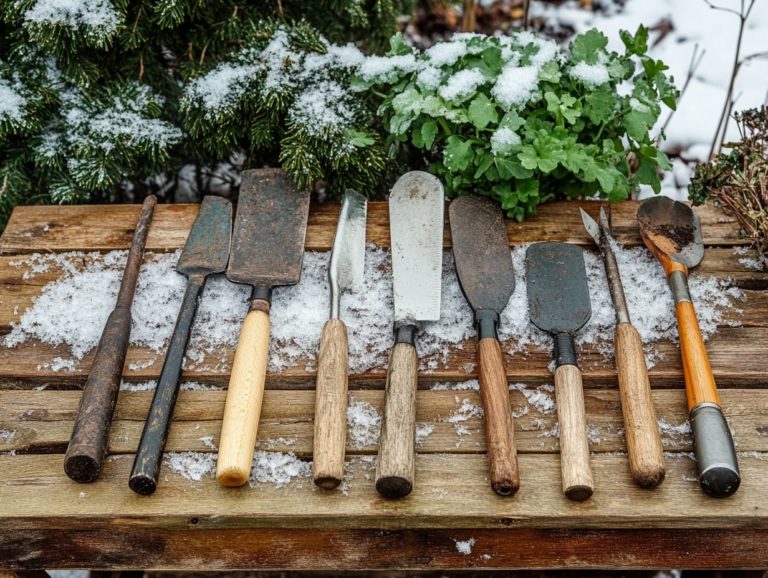Essential Tools for Winter Crop Rotation
Winter crop rotation is an essential practice for any gardener aiming to elevate soil health and maximize yields.
This article delves into the myriad benefits of winter crop rotation. It offers effective planning strategies and introduces essential tools to streamline the process. From soil testing kits to the right gardening implements, you ll find everything necessary to prepare your garden for the chilly months ahead.
Uncover the best winter crops, steer clear of common pitfalls, and explore methods that will pave your path to success. Embark on this journey toward cultivating a thriving winter garden!
Contents
- Key Takeaways:
- Unlocking the Power of Winter Crop Rotation!
- Strategizing for Winter Crop Success
- Essential Tools for Winter Crop Rotation
- 4. Soil Testing Kits
- 5. Garden Fork
- 6. Garden Spade
- 7. Garden Rake
- 8. Garden Hoe
- 9. Garden Trowel
- 10. Garden Scissors
- 11. Garden Gloves
- 12. Garden Kneeler
- 13. Seed Drill
- 14. Garden Sprayer
- 15. Garden Cart
- What Are the Best Crops for Winter Rotation?
- Frequently Asked Questions
- What are the essential tools for winter crop rotation and soil management?
- Why do I need a shovel for winter crop rotation?
- Can I use any type of trowel for winter crop rotation?
- How often should I use pruners during winter crop rotation?
- What is the purpose of a garden fork in winter crop rotation?
- Can a hand rake be used for winter crop rotation?
Key Takeaways:

- Soil testing kits are essential tools for winter crop rotation. They help determine soil nutrient levels and pH, allowing for more targeted crop selection and fertilizer application.
- A garden spade and fork are necessary for turning and aerating the soil. They promote better drainage and root growth for winter crops.
- Crop rotation benefits the soil and helps prevent pest and disease buildup in a specific area. It is crucial for successful winter gardening.
Unlocking the Power of Winter Crop Rotation!
Winter crop rotation offers a wealth of benefits that can elevate your gardening and organic farming practices. By enhancing soil health, preventing diseases, and boosting crop yields, it becomes an essential strategy for sustainability.
When you alternate crops, you disrupt pest cycles and improve soil structure. This leads to a resilient organic garden that flourishes over time.
This practice not only enriches the soil but also supercharges its structure! It reduces compaction and promotes effective drainage.
Varieties like winter rye, hairy vetch, and field peas fix nitrogen and serve as exceptional cover crops. They guard against soil erosion during the colder months.
Experts like Jack Algiere at Stone Barns Center clearly illustrate the advantages of winter rotation. Their work demonstrates that integrating diverse crops can significantly boost biodiversity and yield.
By thoughtfully planning your crop sequences, you can create healthier ecosystems that support both plant and animal life. This leads to a thriving garden.
Strategizing for Winter Crop Success
Proper planning for winter crop rotation is crucial for maximizing your garden space. It ensures that various crop varieties are effectively intercropped for optimal growth and pest control during the colder months, especially when using the best tools for late winter planting.
A well-thought-out planting schedule maintains a steady supply of fresh produce throughout the season. Incorporating succession planting allows you to stagger planting times for different varieties within the same family.
This promotes a continuous harvest and minimizes the risk of crop failure due to pests or diseases.
Understanding the relationships between vegetable families enables you to create a diverse garden. This reduces competition for nutrients while enhancing overall soil health.
This thoughtful approach not only elevates the quality and yield of your produce but also fosters a balanced ecosystem in your garden. It creates a thriving environment for both plants and beneficial insects.
Essential Tools for Winter Crop Rotation
Equipping yourself with the right essential tools for winter gardening success can dramatically enhance your gardening efficiency. This enables you to manage soil health and prepare for planting with unmatched precision and ease.
Among these invaluable tools, a soil test kit stands out as fundamental. It offers deep insights into nutrient levels and pH, allowing you to make targeted amendments.
A quality tiller is equally crucial; it aerates the soil, alleviates compaction, and seamlessly integrates organic matter.
For planting, a seed drill ensures even spacing and minimizes seed wastage. Meanwhile, mulch layers serve a dual purpose suppressing weeds and maintaining soil moisture.
For ongoing maintenance, a cultivator aids in weed control and loosens soil to promote robust root development. Lastly, a dependable harvesting tool, whether a sickle or a hand-held harvester, guarantees efficient crop gathering. This reduces damage and optimizes your yield.
Start planning your winter garden today and share your experiences with winter crop rotation!
4. Soil Testing Kits
Soil testing kits are essential tools for maintaining your soil’s health. They enable you to assess nutrient levels and tailor your sustainable practices during winter crop care rotation.
By offering a clear snapshot of your soil’s nutrient profile, these kits help you pinpoint deficiencies that could impede plant growth. With a deep understanding of your specific nutrient needs, you can make informed choices about crop selection, ensuring that your plants thrive in harmony with the soil conditions.
The results will guide you in making recommendations for improving your soil, whether that involves adding fertilizers or mixing in organic material like compost. This approach not only promotes a balanced ecosystem but also nurtures healthy, productive gardens.
Taking this proactive step will enhance your crop yields while fostering responsible land stewardship, benefiting both the environment and your gardening efforts.
5. Garden Fork
A garden fork is an essential tool for enhancing soil structure. It enables you to aerate and turn the soil with ease, which is crucial for a successful winter crop rotation. For more insights, check out tools essential for cold-climate gardening.
There are several types of garden forks that can elevate this process. The traditional digging fork, with its strong, pointed tines, is perfect for breaking up compacted soil. The border fork excels in more delicate tasks, making it ideal for smaller garden beds.
Each type has its unique role; for example, the sturdy spading fork can handle tougher ground, while a hand fork provides precision in those tight spots. By utilizing these tools for soil preparation, you promote better drainage and root penetration.
This holistic approach is crucial for maintaining soil health, supporting robust root systems, and ensuring a bountiful harvest during the colder months.
6. Garden Spade
The garden spade is a versatile tool that plays a crucial role in your soil management. It makes it easier for you to dig, edge, and plant during winter crop rotation preparation.
This essential gardening implement assists with various tasks, such as breaking up compacted soil, creating seed beds, and incorporating organic matter. All these actions ensure optimal growing conditions for your crops.
When selecting the right spade, consider factors like blade shape, material, and handle length to meet your gardening needs and preferences. Understanding the unique planting techniques required for different vegetable varieties highlights the importance of this tool.
The right spade can significantly enhance your efficiency, whether you re planting root vegetables, leafy greens, or legumes. This ultimately contributes to a bountiful harvest.
7. Garden Rake

A garden rake is essential for leveling soil surfaces, incorporating compost, and preparing plots for winter crop rotation. All these tasks create optimal conditions for growth.
You ll find that different types of rakes, such as landscape rakes, bow rakes, and thatch rakes, serve specific purposes that can elevate your gardening experience.
- Landscape rakes are invaluable for breaking up hard ground and leveling soil, making them ideal for initial groundwork.
- Bow rakes, with their sturdy and rigid design, excel at mixing compost into the soil, ensuring that nutrients are evenly distributed.
- Thatch rakes tackle excess debris, enhancing air circulation within the soil.
By using these tools effectively, you can significantly improve your composting techniques and promote healthier soil management. This will ultimately lead to a thriving garden.
8. Garden Hoe
The garden hoe is an essential tool for weeding and cultivating soil. It plays a crucial role in maintaining optimal planting conditions during the winter season.
Various types of hoes cater to different gardening needs. For instance, the flat hoe is perfect for efficiently clearing soil and weeds from larger areas. In contrast, the pointed hoe is ideal for precise tasks that require digging in tighter spaces. A stirrup hoe is versatile, allowing you to cultivate the soil one moment and effortlessly uproot stubborn weeds the next.
Using these tools correctly can dramatically enhance the health of your garden. Pairing hoeing with effective weeding strategies like removing weeds before they seed helps ward off pest problems. Regularly rotating your planting locations and covering bare soil with mulch (which means adding a protective layer on top of the soil) will further bolster soil health and reduce the risk of infestation.
9. Garden Trowel
A garden trowel is an essential tool in your gardening arsenal. It’s perfect for planting bulbs, seedlings, and small plants, allowing for precise soil management during winter.
Its robust blade cuts through soil effortlessly, making it easy to dig narrow holes for delicate seeds or bulbs. A quality trowel often comes with a comfortable grip, crucial for those long hours of planting.
Thanks to its versatility, the trowel enables you to use various planting techniques, from creating furrows to transplanting. Even if you’re a novice gardener, you can achieve impressive results. This essential tool streamlines your planting process and enhances the overall health of your garden, paving the way for a bountiful vegetable harvest.
10. Garden Scissors
Garden scissors are essential for plant care during winter, allowing for precise pruning and harvesting that are vital for healthy growth.
These tools come in various types, each tailored for a specific purpose. For example, bypass pruners slice through soft stems and delicate plants, while anvil pruners tackle tougher, woody stems.
Understanding which type of scissors to use enhances your harvesting efficiency and minimizes damage to the plants. To maximize your crop yields, keep your scissors well-maintained, regularly sharpened, and sanitized between uses to prevent disease transmission.
Employ proper technique, such as cutting at an angle, to contribute to healthier growth and improved yields.
11. Garden Gloves
Garden gloves are your secret weapon for hand protection during various gardening tasks. They ensure comfort and safety as you master winter gardening techniques.
These gloves are crafted from various materials, each selected for its unique advantages. Leather gloves deliver durability and protection against thorns, making them ideal for handling robust plants. In contrast, fabric gloves offer breathability, keeping sweat at bay during warm afternoons essential for long gardening sessions. Rubberized gloves provide an excellent grip and waterproof capabilities, making them perfect for planting in damp soil.
By choosing the right glove material, you can elevate your gardening efficiency and protect your hands, ultimately fostering healthier practices as you nurture your garden.
12. Garden Kneeler
A garden kneeler significantly enhances your comfort and efficiency while working at ground level. It makes it easier to tend to your crops during the winter.
This versatile tool cushions your knees and transforms into a supportive seat when flipped over. Its sturdy construction provides stability, promoting better posture and minimizing the risk of strain or injury.
The built-in handles make lifting and maneuvering easy, ensuring that even those with limited mobility can enjoy a full day of gardening without discomfort. Investing in a garden kneeler allows you to extend your time in the garden while protecting your joints, boosting your productivity and enhancing the pleasure of nurturing your plants.
13. Seed Drill
A seed drill is an essential tool that guarantees accurate planting depth and spacing. It significantly enhances your crop management and efficiency during winter crop rotation.
By automating the planting process, this innovative implement reduces the labor required for sowing. This allows you to allocate your resources more effectively. Instead of relying on manual techniques, which often lead to uneven planting and wasted seeds, the seed drill employs a consistent method that positions seeds at the optimal depth and distance apart.
Crops like wheat, barley, and legumes benefit greatly from this technology. It not only promotes better germination rates but also minimizes competition among seedlings. This smart strategy guarantees that each plant has ample room to grow, ultimately leading to higher yields and improved productivity over time.
14. Garden Sprayer

A garden sprayer is crucial for your pest control and disease prevention efforts. It enables you to apply treatments with precision during winter crop rotation.
These versatile devices come in a variety of styles:
- Pump sprayers – perfect for smaller areas.
- Backpack sprayers – ideal for larger coverage without frequent refills.
- Battery-operated options – convenient and easy to use.
With these sprayers at your disposal, you can manage pests like aphids and caterpillars effortlessly while also tackling diseases such as powdery mildew. When applying organic treatments, remember to wear protective gear, select the appropriate nozzle for even distribution, and closely follow the product instructions for safety.
15. Garden Cart
A garden cart can be your best ally for transporting and organizing tools and materials. It significantly boosts your gardening efficiency during winter crop rotation preparations.
With a range of designs available, from straightforward utility carts to specialized models with multiple compartments and robust wheels, you’ll find practical solutions for every gardening task. The right cart simplifies gathering supplies and tools and transforms transporting harvested crops into a seamless experience.
For example, a cart with shelving keeps your gardening essentials within easy reach, while larger, all-terrain models can handle heavy loads effortlessly across uneven ground. This versatility saves you precious time and eases the physical strain of gardening chores.
What Are the Best Crops for Winter Rotation?
Selecting the best crops for winter rotation means choosing a diverse range of varieties that thrive in cooler temperatures, including:
- Root vegetables
- Leafy greens
- Legumes
This smart strategy guarantees that your agricultural system remains effective, even in winter s harsh conditions.
These crops do more than just provide sustenance during the off-season; they play a crucial role in enhancing soil fertility and structure. For instance, legumes are known for fixing nitrogen in the soil, enriching it and reducing dependence on chemical fertilizers. Meanwhile, root vegetables like carrots and beets help break up compacted soil, improving nutrient and water absorption.
By implementing cover crops such as clover or rye, you can prevent erosion, suppress weeds, and boost biodiversity. This creates a more resilient farming ecosystem, fostering healthy pest management through natural predation. Get started with these tools today!
How Can Crop Rotation Benefit the Soil?
Crop rotation significantly benefits your soil health. It enhances nutrient levels, improves soil structure, and manages pest populations effectively. It’s truly a cornerstone of sustainable gardening practices.
One standout advantage comes from incorporating plants that add nitrogen back into the soil, like legumes. These plants naturally enrich your soil with vital nutrients, replenishing nitrogen and fostering a diverse microbial ecosystem that supports overall soil fertility.
By alternating between deep-rooted and shallow-rooted plants, you can enhance soil structure. This creates channels for air and moisture, reducing compaction. This balanced approach keeps pests at bay, letting your plants thrive while nurturing the long-term vitality of your soil.
What Are the Common Mistakes to Avoid in Winter Crop Rotation?
Avoiding common mistakes in winter crop rotation is essential for maintaining soil health and preventing pest issues. To enhance your gardening success, consider investing in the right tools by learning how to create a winter gardening toolkit. Poor planning and crop choices can hurt your results and undermine the advantages this practice offers.
To achieve optimal results, consider various factors, including how well the crops align with the prevailing climate and soil conditions. Misunderstanding these elements could lead to inadequate nutrient replenishment and increased vulnerability to diseases.
Failing to create a well-timed planting schedule can mean lost opportunities for maximizing crop growth and yield. By implementing strategies like regular soil testing, selecting complementary crops, and staying informed, you can greatly enhance the effectiveness of winter crop rotation. Additionally, having the right tools is crucial; consider using essential winter gardening supplies to ensure a more sustainable and productive agricultural practice.
How Can One Prepare Their Garden for Winter Crop Rotation?
Preparing your garden for winter crop rotation involves several strategic steps. Start by managing your soil and selecting the right crops. Utilize techniques like growing different plants together to help each other grow to optimize growth.
First, assess the quality of your existing soil. Ensure it has the necessary nutrients to support healthy plants. This might require adding organic matter, such as compost or well-rotted manure, to enhance both fertility and structure.
Next, choosing the right crops is crucial. Diversifying your options with winter legumes or greens can improve soil nutrients while ensuring you enjoy continued harvests. Additionally, techniques like mulching and careful row planning can maximize your space and encourage natural pest control, leading to a more productive garden come spring.
What Are the Different Methods of Crop Rotation?
Understanding the various methods of crop rotation like intercropping and planting rotation is essential for anyone committed to sustainable practices. These methods enhance soil health and elevate crop yields.
By exploring these techniques, you can tailor your gardening strategies to accommodate specific soil conditions and climate nuances. For example, intercropping enables you to combine diverse plants that naturally deter pests and enhance nutrient absorption. Traditional crop rotation emphasizes sequential planting to prevent soil depletion.
Each approach offers unique advantages. When you adapt them thoughtfully, you can foster more resilient ecosystems, healthier plants, and ultimately, more productive harvests. This flexibility is vital for optimizing your gardening practices and achieving the best possible results.
Frequently Asked Questions

What are the essential tools for winter crop rotation and soil management?
The essential tools for winter garden prep include a shovel, trowel, pruners, garden fork, hoe, and hand rake.
Why do I need a shovel for winter crop rotation?
A shovel is necessary for digging and aerating soil, which is important for healthy root growth and nutrient absorption.
Can I use any type of trowel for winter crop rotation?
It is recommended to use a hand trowel with a pointed tip for precision digging and transplanting small plants during winter crop rotation, especially when considering gardening in the snow: essential tools.
How often should I use pruners during winter crop rotation?
Use pruners regularly during winter. This helps keep plants trimmed and healthy, which is key for their growth.
What is the purpose of a garden fork in winter crop rotation?
A garden fork loosens and aerates compacted soil. It also mixes in materials like compost and fertilizers to boost soil quality.
Can a hand rake be used for winter crop rotation?
Yes! A hand rake is perfect for leveling soil and removing debris. You can also use it to create furrows for planting seeds.






